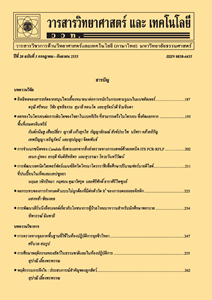วิธีการวิเคราะห์ไอโอดีนในเกลือที่เหมาะสมสำหรับสถานประกอบการเกลือขนาดกลางและเล็ก
Main Article Content
Abstract
บทคัดย่อ
วิธีการตรวจสอบปริมาณไอโอดีนในเกลือเชิงกึ่งปริมาณและเชิงปริมาณมีการพัฒนา และนำไปใช้ในสถานประกอบการขนาดกลางและเล็ก อย่างไรก็ตาม ยังพบปัญหาหลังนำไปใช้งานจริงในสถานประกอบการ การศึกษานี้จึงมีวัตถุประสงค์เพื่อประเมินความถูกต้องของวิธีวิเคราะห์ต่าง ๆ ที่มีการใช้เพื่อหาปริมาณไอโอดีนในเกลือ เก็บตัวอย่างเกลือที่มีการเสริมไอโอดีนด้วยโพแทสเซียมไอโอเดตที่ระดับ 20-40 มิลลิกรัมต่อกิโลกรัม (พีพีเอ็ม) จากสถานประกอบการผลิตเกลือ ในพื้นที่ภาคตะวันออกเฉียงเหนือ ภาคกลาง และภาคใต้ของประเทศไทย โดยเป็นเกลือสินเธาว์ 80 ตัวอย่าง และเกลือทะเล 60 ตัวอย่าง วิเคราะห์ปริมาณไอโอดีนด้วย 4 วิธี ได้แก่ (ก) วิธีไตรเตรชั่น ซึ่งเป็นวิธีมาตรฐาน (ข) วิธีไอรีดเดอร์แบบปกติ (ประมาณเกลือ 0.1 กรัม) (ค) วิธีไอรีดเดอร์แบบชั่งเกลือ 10 กรัม และ (ง) ไอคิดที่ดัดแปลงการอ่านด้วยไม้บรรทัด ผลการศึกษาที่วิเคราะห์ด้วยวิธีไตรเตรชั่นพบว่าตัวอย่างเกลือเสริมไอโอดีนที่ผสมด้วยเครื่องผสมแบบเกลียวคู่ มีปริมาณไอโอดีนอยู่ในช่วง 20-40 มิลลิกรัมต่อกิโลกรัม และร้อยละความแปรปรวนน้อยกว่าร้อยละ 10 ในขณะที่เครื่องผสมแบบอื่น ๆ พบว่าไม่ผ่านทั้งสองเกณฑ์ การวิเคราะห์หาความสัมพันธ์ของวิธีวิเคราะห์ต่าง ๆ เปรียบเทียบกับไตรเตรชั่นพบว่ามีค่า 0.99, 0.87 และ 0.83 สำหรับการวิเคราะห์ด้วยวิธีไอรีดเดอร์แบบชั่ง 10 กรัม วิธีไอรีดเดอร์แบบช้อนตัก 0.1 กรัม และวิธีไอคิดที่ดัดแปลงการอ่านด้วยไม้บรรทัด ตามลำดับ ถึงแม้ว่าวิธีวิเคราะห์ต่าง ๆ มีความสัมพันธ์ที่ดีกับวิธีไตรเตรชั่นแต่พบว่าค่าความถูกต้องไม่ดี การใช้วิธีวิเคราะห์ปริมาณไอโอดีนด้วยวิธีไอรีดเดอร์แบบ 10 กรัม และวิธีไอคิดที่ดัดแปลงการอ่านด้วยไม้บรรทัด มีความเหมาะสมกับสถานประกอบการขนาดกลางและเล็ก ด้วยความตระหนักว่าเป็นวิธีเชิงกึ่งปริมาณเท่านั้น วิธีไตรเตรชั่นเป็นวิธีมาตรฐานที่เหมาะสมต่อการบังคับใช้กฎหมายควบคุมการผลิตเกลือเสริมไอโอดีน
คำสำคัญ : เกลือเสริมไอโอดีน; วิธีวิเคราะห์; ระบบควบคุมคุณภาพ; ผู้ประกอบการผลิตเกลือ
Abstract
Both semi-quantitative and quantitative analytical methods for iodine analysis in salt are introduced and implemented at small and medium scale producers. However, their feasibilities in using at the small and medium scale producers were still in doubt. This study aimed to evaluate the accuracy of the available salt iodine analytical methods. Salts fortified with potassium iodate at 20-40 mg kg-1 (ppm) were sampled from the production sites located in the northeastern, central and southern parts of Thailand. The iodized salt samples (80 of rock salt and 60 of sea salt) were analyzed by using 4 methods, i.e. (i) standard titration, (ii) I-reader (0.1 g salt), (iii) modified I-reader (10 g salt), and (iv) modified I-kit (read on developed color-scale ruler). The results from the titration method indicated that the fortification of iodine levels using double ribbon mixing provided both iodine within 20-40 mg kg-1 and coefficient of variance, CV < 10 %. Other type of batch mixing and continuous mixing process still have problem on both criteria. The correlations with the results from titration methods of salts were 0.99, 0.87 and 0.83 for the modified I-reader, I-reader and modified I-kit, respectively. Although values read from analytical methods other than the titration method have good correlation but the accurate are not good. In case of small and medium scale producers, it could be compromise for the I-reader (10 g) or modified I-kit with the awareness that they could be only for semi-quantitative tests. The standard titration method is still required for quality control especially for mandatory action.
Keywords: iodized salt; analytical method; quality control system; salt producer


